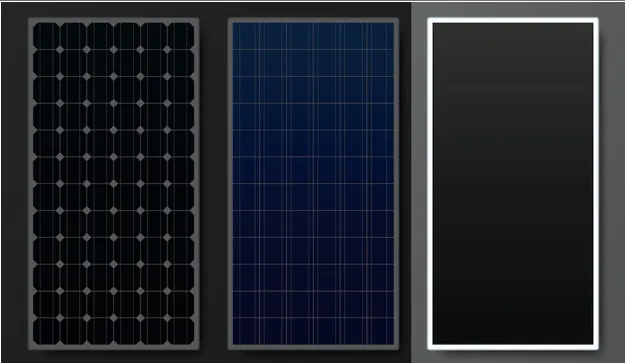As the world moves closer to adopting renewable energy, solar power generation stands out as one of the most reliable and scalable solutions for energy production. With increasing demand, innovations in solar technology have led to the development of different solar panel types, each designed to serve specific needs, conditions, and efficiency levels.
Understanding these panel types is essential if you are considering solar adoption for your home, business, or large-scale projects. Let’s take a closer look at the six most widely used types of solar panels, their unique features, and how they contribute to the clean energy revolution.
1. Monocrystalline Solar Panels
Monocrystalline panels are among the most widely used solar panel types worldwide. These panels are made from single-crystal silicon, which is why they are named after it.
-
Efficiency: Typically between 15% and 22%, making them one of the most efficient options.
-
Appearance: They have a uniform black look, giving them a sleek design.
-
Performance: Excellent in areas with limited space, as fewer panels are needed to generate significant electricity.
Best suited for: Homeowners with limited rooftop space who seek high efficiency and long-term durability.
2. Polycrystalline Solar Panels
Polycrystalline panels are another popular type of solar technology. Unlike monocrystalline panels, they are made from multiple silicon crystals melted together.
-
Efficiency: Around 13–17%, slightly lower than monocrystalline.
-
Appearance: Blue in color with a speckled look.
-
Performance: An affordable option, but it requires more space compared to monocrystalline panels.
Best for: Those looking for budget-friendly solar installations where space is not a constraint.
3. Thin-Film Solar Panels
Thin-film panels are lightweight and flexible, making them different from traditional crystalline panels. They are manufactured by layering photovoltaic materials, such as cadmium telluride (CdTe) or amorphous silicon (a-Si).
-
Efficiency: Ranges between 10–12%.
-
Appearance: Slim, lightweight design; often frameless.
-
Performance: Ideal for large commercial projects or unconventional spaces, such as those with curved surfaces.
Best for: Large-scale utility projects or buildings where weight and design flexibility are important.
4. Passivated Emitter and Rear Cell (PERC) Panels
PERC solar panels are an advanced version of monocrystalline technology. They feature an additional layer at the back that reflects sunlight into the cell, boosting efficiency.
-
Efficiency: 17–23%, making them more potent than standard monocrystalline solar panels.
-
Durability: Performs better in low-light conditions and high temperatures.
-
Performance: Higher energy yield without requiring additional installation space.
Best suited for: Both residential and commercial projects that aim for maximum output from limited space.
5. Bifacial Solar Panels
Bifacial panels are one of the most innovative solar panel types available today. These panels can absorb sunlight from both sides, increasing energy generation.
-
Efficiency: Up to 25% higher than traditional panels due to dual absorption.
-
Design: Transparent or semi-transparent backing allows sunlight to reflect onto the rear side.
-
Performance: Best suited for areas with high albedo surfaces (reflective ground, white rooftops, or sandy regions).
Best for: Large solar farms, commercial rooftops, and projects in reflective environments.
6. Concentrated Photovoltaic (CPV) Panels
Concentrated photovoltaic panels use lenses or mirrors to focus sunlight onto highly efficient solar cells. Unlike other panel types, they require solar tracking systems for alignment.
-
Efficiency: Can reach 40% or more under optimal conditions.
-
Technology: Uses advanced optics and tracking systems.
-
Performance: Very high efficiency, but costly and requires direct sunlight.
Best for: Utility-scale projects in regions with strong, direct sunlight throughout the year.
Comparative Table of Solar Panel Types
Solar Panel Type |
Efficiency |
Cost |
Best Application |
Monocrystalline |
15–22% |
High |
Residential rooftops, space-limited areas |
Polycrystalline |
13–17% |
Medium |
Budget-friendly installations |
Thin-Film |
10–12% |
Low |
Commercial projects, unconventional roofs |
PERC |
17–23% |
Medium-High |
Residential + Commercial high-yield needs |
Bifacial |
Up to 25% |
High |
Solar farms, reflective surfaces |
Concentrated Photovoltaic |
40%+ |
Very High |
Utility-scale in sunny regions |
This table highlights how each panel type balances efficiency, cost, and application. Choosing the right one depends on your location, budget, and energy needs.
Factors to Consider Before Choosing Solar Panels
When selecting from different solar panel types, it’s important to consider a few key factors:
-
Space Availability – Limited rooftops favor high-efficiency panels, such as monocrystalline or PERC, due to their increased energy output.
-
Budget – Polycrystalline or thin-film options are better for those seeking affordability.
-
Climate Conditions – In hotter climates, panels like PERC and bifacial perform better.
-
Project Scale – Large-scale commercial or utility projects can benefit from thin-film or CPV panels.
-
Aesthetic Preference – Monocrystalline panels offer a modern, sleek design for residential use.


